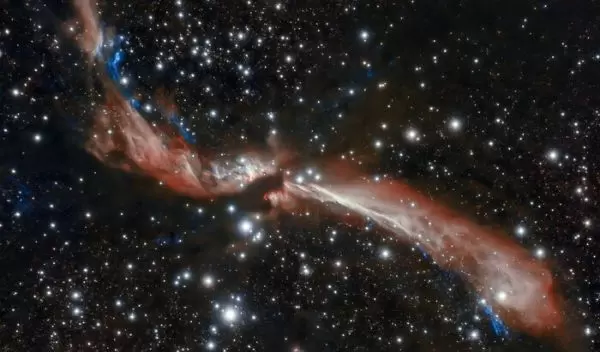
Gemini South captures remarkably clear images of two sidewinding stellar jets
An international team of astronomers using the International Gemini Observatory, a program of the U.S. National Science Foundation's NOIRLab, has captured crystal-clear images of two wiggling stellar jets from nearby forming stars.
The images were captured by the Gemini South Adaptive Optics Imager, an instrument on the Gemini South telescope. The imaging system works with the Gemini Multi-conjugate Adaptive Optics System to reduce blurring and distortion from atmospheric turbulence. The astronomers detailed their observations inAstronomy & Astrophysics.
Young stellar jets are a byproduct of forming stars. As gas from the surrounding cloud spirals down onto the young star through an accretion disk, like water circling the drain in a bathtub, the star's magnetic field drives supersonic jets from the poles of the star. Most stellar jets are straight, though some appear curved or helical. The uneven shape of these jets could be caused by the misaligned rotational axis of the young star or stars driving the jet.
The stars that created the two bipolar jets, MHO 2147 and MHO 1502, are obscured from view by surrounding clouds of gas and dust. The youngest stars are often hidden from view, even at infrared wavelengths. The molecular cloud associated with MHO 2147 is about 10,000 light-years from Earth. It lies in the galactic plane of the Milky Way, close to the border between the Sagittarius and Ophiuchus constellations. MHO 1502, meanwhile, is located in the Vela constellation, approximately 2,000 light-years away. The molecular cloud that harbors MHO 1502 and its central star are associated with a region where a portion of the cloud is ionized by surrounding very bright stars.
The clarity of images produced offers astronomers a view of the stellar jets with a remarkable level of detail. This milestone, scientists say, is a result of NSF's ongoing commitment to advancing research, innovation and cutting-edge infrastructure.
The Gemini Observatory is owned and operated by an international partnership that includes the United States, Canada, Chile, Brazil, Argentina and the Republic of Korea.


